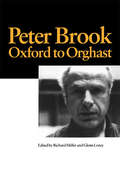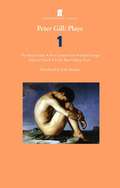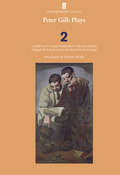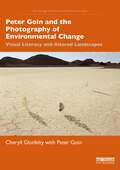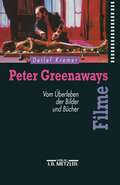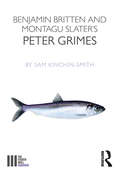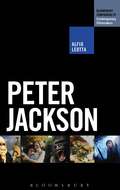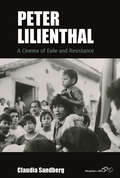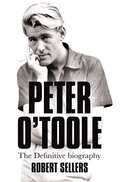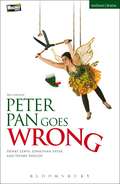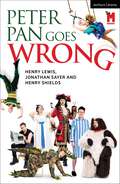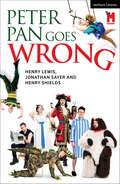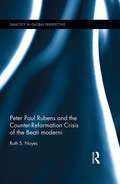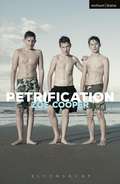- Table View
- List View
Peter Brook: Oxford to Orghast
by R. Helfer G. LoneyPeter Brook is known internationally as a theatre visionary, and a daring experimenter on the cutting-edge of performance and production. This book concentrates on Brook's early years, and his innovative achievements in opera, television, film, and the theatre. His productions are viewed separately, in chronological order, suggesting Brook's developing and changing interests. The authors include thought-provoking interviews with Brook (and with numerous outstanding artists who have worked with him) and bring to the reader penetrating critiques of Brook's theories and practices as a man of the theatre.
Peter Gill Plays 1
by Peter GillThis first collection of Peter Gill's plays spans his work from 1965 to 1987. The plays are studies of love and time, loss and the fear of loss. The collection includes the plays The Sleepers Den, Over Gardens Out, Small Change, Kick for Touch, In The Blue and Mean Tears, and is introduced by John Burgess.
Peter Gill Plays 2: Cardiff East, Certain Young Men, The York Realist, Original Sin
by Peter GillCardiff East 'As scene melts into scene, oneâ?Ts appetite for knowing more and more about these people is constantly whetted, even for the ones one would avoid in real life. Each and every [character] rings true and resonates further. . . A play which is never less than gripping.' Mail on Sunday Certain Young Men 'The play is marked by a fast turnover of scenes, lots of brusque, vivid, wryly funny dialogue . . . articulate, arresting and as freshly performed as anything in town.' The Times The York Realist: Winner of the London Critics' Circle Award for Best New Play 'As a love story, The York Realist is riveting and heart-rending, performed with fine-tuned naturalism that's quiet and unhurried. Gill is always terrifically perceptive about male tenderness. Overall, the personal and political are subtly united in a study of English masculinity, class and culture. Such outstanding work.'Independent on Sunday Original Sin 'Hauntingly powerful.' Guardian
Peter Goin and the Photography of Environmental Change: Visual Literacy and Altered Landscapes (Routledge Environmental Humanities)
by Peter Goin Cheryll GlotfeltyPeter Goin and the Photography of Environmental Change narrates the forty-year quest of award-winning and internationally exhibited contemporary photographer Peter Goin to document human-altered landscapes across America and beyond. It is a collaborative work between an artist and a literary critic, a retrospective of an accomplished environmental photographer, and an innovative education in visual reading. Enduring howling wind, pounding rain, and blistering sun, Goin bears witness to radioactive landscapes, abandoned mines, simulated swamps, rechanneled rivers, controlled burns, overgrown ruins, industrialized agriculture, shrinking reservoirs, feral spaces in the city, architected wilderness, sacred wastelands, contested borderlands, and more. Based on more than seventy hours of taped interviews with the artist spanning over a decade, trailblazing ecocritic Cheryll Glotfelty narrates the arc of Goin's career, sharing excerpts from their conversations that reveal his brilliant mind and piquant personality while situating his work within the broader context of environmental thinkers. This beautifully illustrated volume, with 200 images in color and black-and-white showcasing Goin’s work, will be a fascinating and insightful read for upper-level students, academics, and researchers in photography, environmental history and culture, landscape studies, and environmental humanities.
Peter Goin and the Photography of Environmental Change: Visual Literacy and Altered Landscapes (Routledge Environmental Humanities)
by Peter Goin Cheryll GlotfeltyPeter Goin and the Photography of Environmental Change narrates the forty-year quest of award-winning and internationally exhibited contemporary photographer Peter Goin to document human-altered landscapes across America and beyond. It is a collaborative work between an artist and a literary critic, a retrospective of an accomplished environmental photographer, and an innovative education in visual reading. Enduring howling wind, pounding rain, and blistering sun, Goin bears witness to radioactive landscapes, abandoned mines, simulated swamps, rechanneled rivers, controlled burns, overgrown ruins, industrialized agriculture, shrinking reservoirs, feral spaces in the city, architected wilderness, sacred wastelands, contested borderlands, and more. Based on more than seventy hours of taped interviews with the artist spanning over a decade, trailblazing ecocritic Cheryll Glotfelty narrates the arc of Goin's career, sharing excerpts from their conversations that reveal his brilliant mind and piquant personality while situating his work within the broader context of environmental thinkers. This beautifully illustrated volume, with 200 images in color and black-and-white showcasing Goin’s work, will be a fascinating and insightful read for upper-level students, academics, and researchers in photography, environmental history and culture, landscape studies, and environmental humanities.
Peter Grimes
by Sam Kinchin-Smithã `Who can turn skies back and begin again?' -Peter ã This book contends that Peter Grimes, widely regarded as one of the greatest and most influential operas of the 20th century, is also one of the British theatre's finest `lost' plays. Seeking to liberate Britten and Slater's work from the blinkered traditions of theatre and opera criticism, Sam Kinchin-Smith poses two questions: If an opera was created like a play, and can be staged as a play, is it a play? If a portion of its success and influence is the product of this newly identified theatrical engine, is it then a great play? The answers involve Wagner and W.G. Sebald, George Crabbe and Complicite, Akenfield and Twin Peaks. Challenging long-established narratives of post-war theatre history, this book makes a compelling case for why practitioners and scholars of performance ought to pay more attention to Britten and Slater's achievement - a milestone of unconventional English modernism - and perhaps to other operatic masterpieces too.
Peter Grimes (The\fourth Wall Ser.)
by Sam Kinchin-Smithã `Who can turn skies back and begin again?' -Peter ã This book contends that Peter Grimes, widely regarded as one of the greatest and most influential operas of the 20th century, is also one of the British theatre's finest `lost' plays. Seeking to liberate Britten and Slater's work from the blinkered traditions of theatre and opera criticism, Sam Kinchin-Smith poses two questions: If an opera was created like a play, and can be staged as a play, is it a play? If a portion of its success and influence is the product of this newly identified theatrical engine, is it then a great play? The answers involve Wagner and W.G. Sebald, George Crabbe and Complicite, Akenfield and Twin Peaks. Challenging long-established narratives of post-war theatre history, this book makes a compelling case for why practitioners and scholars of performance ought to pay more attention to Britten and Slater's achievement - a milestone of unconventional English modernism - and perhaps to other operatic masterpieces too.
Peter Jackson (The Bloomsbury Companions to Contemporary Filmmakers)
by Alfio LeottaPeter Jackson is one of the most acclaimed and influential contemporary film-makers. This is the first book to combine the examination of Jackson's career with an in-depth critical analysis of his films, thus providing readers with the most comprehensive study of the New Zealand film-maker's body of work. The first section of the book concentrates on Jackson's biography, surveying the evolution of his career from the director of cult slapstick movies such as Meet the Feebles (1989) and Braindead (1992) to an entrepreneur responsible for the foundation of companies such as Wingnut Films and Weta Workshop, and finally to producer and director of mega blockbuster projects such as The Lord of the Rings (2001-2003) and The Hobbit (2012-2013).The book further examines Jackson's work at the level of production, reception and textuality, along with key collaborative relationships and significant themes associated with Jackson's films. The examination of Peter Jackson's work and career ties into significant academic debates, including the relationship between national cinema and global Hollywood; the global dispersal of film production; the relationship between film authorship and industrial modes of production; the impact of the creative industries on the construction of national identity; and new developments in film technology.
Peter Jackson (The Bloomsbury Companions to Contemporary Filmmakers)
by Alfio LeottaPeter Jackson is one of the most acclaimed and influential contemporary film-makers. This is the first book to combine the examination of Jackson's career with an in-depth critical analysis of his films, thus providing readers with the most comprehensive study of the New Zealand film-maker's body of work. The first section of the book concentrates on Jackson's biography, surveying the evolution of his career from the director of cult slapstick movies such as Meet the Feebles (1989) and Braindead (1992) to an entrepreneur responsible for the foundation of companies such as Wingnut Films and Weta Workshop, and finally to producer and director of mega blockbuster projects such as The Lord of the Rings (2001-2003) and The Hobbit (2012-2013).The book further examines Jackson's work at the level of production, reception and textuality, along with key collaborative relationships and significant themes associated with Jackson's films. The examination of Peter Jackson's work and career ties into significant academic debates, including the relationship between national cinema and global Hollywood; the global dispersal of film production; the relationship between film authorship and industrial modes of production; the impact of the creative industries on the construction of national identity; and new developments in film technology.
Peter Jennings: A Reporter's Life (Thorndike Nonfiction Ser.)
by Lynn Sherr Kate Darnton Kayce Freed JenningsPeter Jennings was the sole anchor of ABC's World News Tonight from 1983 until his death from cancer in 2005. For many Americans, he was the voice and face that gave shape and meaning to every day's news. But who was Peter Jennings really? In this absorbing biography, readers will get to know Jennings through the memories of his friends, family, competitors, colleagues, and interview subjects. Their stories are full of surprises. Jennings, we learn, was a high school dropout who spent the rest of his life in pursuit of knowledge. He traveled the world in search of stories, a notebook perpetually thrust through his back belt loop. In his front pocket, he carried a miniature copy of the Constitution, a testament to his love for the United States; a Canadian by birth, Jennings acquired American citizenship in 2003.Peter Jennings was a celebrity, of course-a dashingly handsome and elegant man, famous for his ability to charm women and world leaders alike-but in these pages he is remembered as a loyal friend and a devoted family man, who loved nothing more than to canoe with his kids and listen to jazz with his friends in the Hamptons. Not that he was the relaxing sort. Jennings was a task-master, who ripped other reporters' pieces to shreds, forcing them to rewrite from the ground up. He was a perfectionist, too, who drove his fellow correspondents crazy with his ad-libbed questions on the air. It was all about standards. Throughout his life, Peter Jennings was driven by a passion to seek the truth and convey that truth accurately, simply, cleanly, and elegantly to his American audience. He was our voice.
Peter Jennings: A Reporter's Life
by Lynn Sherr Kate Darnton Kayce Freed JenningsPeter Jennings was the sole anchor of ABC's World News Tonight from 1983 until his death from cancer in 2005. For many Americans, he was the voice and face that gave shape and meaning to every day's news. But who was Peter Jennings really? In this absorbing biography, readers will get to know Jennings through the memories of his friends, family, competitors, colleagues, and interview subjects. Their stories are full of surprises. Jennings, we learn, was a high school dropout who spent the rest of his life in pursuit of knowledge. He traveled the world in search of stories, a notebook perpetually thrust through his back belt loop. In his front pocket, he carried a miniature copy of the Constitution, a testament to his love for the United States; a Canadian by birth, Jennings acquired American citizenship in 2003. Peter Jennings was a celebrity, of course -- a dashingly handsome and elegant man, famous for his ability to charm women and world leaders alike -- but in these pages he is remembered as a loyal friend and a devoted family man, who loved nothing more than to canoe with his kids and listen to jazz with his friends in the Hamptons. Not that he was the relaxing sort. Jennings was a task-master, who ripped other reporters' pieces to shreds, forcing them to rewrite from the ground up. He was a perfectionist, too, who drove his fellow correspondents crazy with his ad-libbed questions on the air. It was all about standards. Throughout his life, Peter Jennings was driven by a passion to seek the truth and convey that truth accurately, simply, cleanly, and elegantly to his American audience. He was our voice.
Peter Kennard: Visual Dissent
by Peter KennardThis fully illustrated anthology showcases key images from Peter Kennard's work as Britain's foremost political artist over the last fifty years.The book centres around Kennard's images, photomontages and illustrations from protests, year by year, which provoked public outrage; including Israel/Palestine protests, anti-nuclear protests, responses to austerity, climate destruction, and more. Each image is accompanied by captions detailing not only the events in question, but Kennard's approach to the work, including the genesis of the images and the techniques employed. Ultimately, the book highlights Kennard's extraordinary contribution to political art in the twenty-first century.
Peter Lilienthal: A Cinema of Exile and Resistance (Film Europa #25)
by Claudia SandbergBest known for his 1979 film David, Peter Lilienthal was an unusual figure within postwar filmmaking circles. A child refugee from Nazi Germany who grew up in Uruguay, he was uniquely situated at the crossroads of German, Jewish, and Latin American cultures: while his work emerged from West German auteur filmmaking, his films bore the unmistakable imprints of Jewish thought and the militant character of New Latin American cinema. Peter Lilienthal is the first comprehensive study of Lilienthal’s life and career, highlighting the distinctively cross-cultural and transnational dimensions of his oeuvre, and exploring his role as an early exemplar of a more vibrant, inclusive European film culture.
Peter Lorre: Constructing Stardom and Performance in Hollywood and Europe (Film Europa #12)
by Sarah ThomasPeter Lorre described himself as merely a ‘face maker’. His own negative attitude also characterizes traditional perspectives which position Lorre as a tragic figure within film history: the promising European artist reduced to a Hollywood gimmick, unable to escape the murderous image of his role in Fritz Lang’s M. This book shows that the life of Peter Lorre cannot be reduced to a series of simplistic oppositions. It reveals that, despite the limitations of his macabre star image, Lorre’s screen performances were highly ambitious, and the terms of his employment were rarely restrictive. Lorre’s career was a complex negotiation between transnational identity, Hollywood filmmaking practices, the ownership of star images and the mechanics of screen performance.
Peter Moro and Partners (Twentieth Century Architects)
by Alistair FairPeter Moro is the forgotten co-designer of the Royal Festival Hall. A German émigré who had worked with Berthold Lubetkin’s famed practice, Tecton, in the 1930s, Moro was drafted in to help realise the Festival Hall in just two short years, in time for the Festival of Britain in 1951. With a team of his former students, he created many of the interiors we see today. For Moro, the Festival Hall was a stepping-stone to a career designing many of Britain’s finest post-war theatres, particularly Nottingham Playhouse, Plymouth Theatre Royal, and the renovated Bristol Old Vic. He and his colleagues also designed some exceptional one-off houses, as well as exhibitions, university buildings, schools, and council housing, collaborating with leading talents such as the designer Robin Day. Based on detailed archival research and with stunning new photography, this is the first book devoted to the work of Peter Moro and his colleagues in architectural practice. Ranging from the 1930s to the 1980s, it explores Moro’s belief in a rigorous modern architecture which was both functionally sound and aesthetically rich. It sheds new light on this important body of work, and enriches our understanding of the experience and diversity of modernism in Britain.
Peter O'Toole: The Definitive Biography
by Robert SellersPeter O'Toole was supremely talented, a unique leading man and one of the most charismatic and unpredictable actors of his generation. Described by Richard Burton as 'the most original actor to come out of Britain since the war', O'Toole regularly seemed to veer towards self-destruction.With the help of exclusive interviews with colleagues and close friends, Peter O'Toole: The Definitive Biography paints the first complete picture of this much loved man and reveals what drove him to extremes, why he drank to excess and hated authority. But it also describes a man who was fiercely intelligent, with a great sense of humour and huge energy. Always insightful, at times funny, at times deeply moving, this is a fitting tribute to an iconic actor who made a monumental contribution to theatre and cinema.
Peter Pan Goes Wrong (Modern Plays)
by Henry Lewis Henry Shields Jonathan SayerTonight Neverland is fleshed out with plenty of plant life, certainly bettering 2011's production of Jack and the Bean-Cactus. So, with no further ado, please put your hands together for J.M. Barrie's Christmas classic: Peter Pan!The inept and accident-prone Cornley Polytechnic Drama Society set out to present J. M. Barrie's classic tale of Peter Pan, their most audacious production to date. Flying? Pyrotechnics? Sharp hooks? What ensues is two acts of hysterical disaster. You'll laugh, they'll cry. Something so wrong has never been so right.From the mischievous minds of the West End and Edinburgh hit The Play That Goes Wrong comes this highly original, chaos-filled re-telling of J.M. Barrie's much-loved classic.Peter Pan Goes Wrong received its world premiere at the Pleasance Theatre, London, on 10 December 2013 and transferred to the West End on 4 December 2015. This edition was published to coincide with the West End transfer.
Peter Pan Goes Wrong (Modern Plays)
by Henry Lewis Henry Shields Jonathan SayerTonight Neverland is fleshed out with plenty of plant life, certainly bettering 2011's production of Jack and the Bean-Cactus. So, with no further ado, please put your hands together for J.M. Barrie's Christmas classic: Peter Pan!The inept and accident-prone Cornley Polytechnic Drama Society set out to present J. M. Barrie's classic tale of Peter Pan, their most audacious production to date. Flying? Pyrotechnics? Sharp hooks? What ensues is two acts of hysterical disaster. You'll laugh, they'll cry. Something so wrong has never been so right.From the mischievous minds of the West End and Edinburgh hit The Play That Goes Wrong comes this highly original, chaos-filled re-telling of J.M. Barrie's much-loved classic.Peter Pan Goes Wrong received its world premiere at the Pleasance Theatre, London, on 10 December 2013 and transferred to the West End on 4 December 2015. This edition was published to coincide with the West End transfer.
Peter Pan Goes Wrong: 2023 West End Edition (Modern Plays)
by Mr Henry Lewis Jonathan Sayer Mr Henry ShieldsIn one of Chris' productions, due to an ill-timed haircut Rapunzel had to be imprisoned in a bungalow. But now with no further ado, please put your hands together for J.M. Barrie's Christmas classic: Peter Pan!The inept and accident-prone Cornley Polytechnic Drama Society set out to present J. M. Barrie's classic tale of Peter Pan, their most audacious production to date. Flying? Pyrotechnics? Sharp hooks? What ensues is two acts of hysterical disaster. You'll laugh, they'll cry. Something so wrong has never been so right.From the mischievous minds of the West End and Edinburgh hit The Play That Goes Wrong comes this highly original, chaos-filled re-telling of J.M. Barrie's much-loved classic.Peter Pan Goes Wrong received its world premiere at the Pleasance Theatre, London, on 10 December 2013 and transferred to the West End on 4 December 2015. The show opened on Broadway on 19 April 2023, and this updated edition was published to coincide with the show returning to the West End for a limited 2023 Christmas season.
Peter Pan Goes Wrong: 2023 West End Edition (Modern Plays)
by Mr Henry Lewis Jonathan Sayer Mr Henry ShieldsIn one of Chris' productions, due to an ill-timed haircut Rapunzel had to be imprisoned in a bungalow. But now with no further ado, please put your hands together for J.M. Barrie's Christmas classic: Peter Pan!The inept and accident-prone Cornley Polytechnic Drama Society set out to present J. M. Barrie's classic tale of Peter Pan, their most audacious production to date. Flying? Pyrotechnics? Sharp hooks? What ensues is two acts of hysterical disaster. You'll laugh, they'll cry. Something so wrong has never been so right.From the mischievous minds of the West End and Edinburgh hit The Play That Goes Wrong comes this highly original, chaos-filled re-telling of J.M. Barrie's much-loved classic.Peter Pan Goes Wrong received its world premiere at the Pleasance Theatre, London, on 10 December 2013 and transferred to the West End on 4 December 2015. The show opened on Broadway on 19 April 2023, and this updated edition was published to coincide with the show returning to the West End for a limited 2023 Christmas season.
Peter Paul Rubens and the Counter-Reformation Crisis of the Beati moderni (Sanctity in Global Perspective)
by Ruth S. NoyesPeter Paul Rubens and the Crisis of the Beati Moderni takes up the question of the issues involved in the formation of recent saints - or Beati moderni (modern Blesseds) as they were called - by the Jesuits and Oratorians in the new environment of increased strictures and censorship that developed after the Council of Trent with respect to legal canonization procedures and cultic devotion to the saints. Ruth Noyes focuses particularly on how the new regulations pertained to the creation of emerging cults of those not yet canonized, the so-called Beati moderni, such as Jesuit founders Francis Xavier and Ignatius Loyola, and Filippo Neri, founder of the Oratorians. Centrally involved in the book is the question of the fate and meaning of the two altarpiece paintings commissioned by the Oratorians from Peter Paul Rubens. The Congregation rejected his first altarpiece because it too specifically identified Filippo Neri as a cult figure to be venerated (before his actual canonization) and thus was caught up in the politics of cult formation and the papacy’s desire to control such pre-canonization cults. The book demonstrates that Rubens' second altarpiece, although less overtly depicting Neri as a saint, was if anything more radical in the claims it made for him. Peter Paul Rubens and the Crisis of the Beati Moderni offers the first comparative study of Jesuit and Oratorian images of their respective would-be saints, and the controversy they ignited across Church hierarchies. It is also the first work to examine provocative Philippine imagery and demonstrate how its bold promotion specifically triggered the first wave of curial censure in 1602.
Peter Paul Rubens and the Counter-Reformation Crisis of the Beati moderni (Sanctity in Global Perspective)
by Ruth S. NoyesPeter Paul Rubens and the Crisis of the Beati Moderni takes up the question of the issues involved in the formation of recent saints - or Beati moderni (modern Blesseds) as they were called - by the Jesuits and Oratorians in the new environment of increased strictures and censorship that developed after the Council of Trent with respect to legal canonization procedures and cultic devotion to the saints. Ruth Noyes focuses particularly on how the new regulations pertained to the creation of emerging cults of those not yet canonized, the so-called Beati moderni, such as Jesuit founders Francis Xavier and Ignatius Loyola, and Filippo Neri, founder of the Oratorians. Centrally involved in the book is the question of the fate and meaning of the two altarpiece paintings commissioned by the Oratorians from Peter Paul Rubens. The Congregation rejected his first altarpiece because it too specifically identified Filippo Neri as a cult figure to be venerated (before his actual canonization) and thus was caught up in the politics of cult formation and the papacy’s desire to control such pre-canonization cults. The book demonstrates that Rubens' second altarpiece, although less overtly depicting Neri as a saint, was if anything more radical in the claims it made for him. Peter Paul Rubens and the Crisis of the Beati Moderni offers the first comparative study of Jesuit and Oratorian images of their respective would-be saints, and the controversy they ignited across Church hierarchies. It is also the first work to examine provocative Philippine imagery and demonstrate how its bold promotion specifically triggered the first wave of curial censure in 1602.
Peter Weiss und der Surrealismus: Poetische Verfahrensweisen in der „Ästhetik des Widerstands“ (Kulturwissenschaftliche Studien zur Deutschen Literatur)
by Christian BommertIm Mittelpunkt dieser Studie steht Peter Weiss'Auseinandersetzung mit dem französischen Surrealismus.Der Autor arbeitet die Bedeutungsvielfalt des Traumbegriffs heraus, der sich als Schlüssel für die Verhaltensweisen und Kunstmittel erweist, die Weiss in der Ästhetik des Widerstands" anwendet. Er zeigt, daß in Peter Weiss' Romanwerk das surrealistische Projekt aktualisiert, aber zugleich verändert ist: Statt den aussichtslosen Versuch fortzusetzen, Kunst in die Lebenswelt zu überführen, setzt Peter Weiss den Lesereiner Textpraxis aus, die der Turbulenz der Lebenswirklichkeit gerecht zu werden versucht.
Petrification (Modern Plays)
by Zoe CooperThe night before the funeral was when he told us that he was getting the lot and I said, I said only then in retaliation, you know, and I am not proud of this, but how Dad had, how he had smashed his glass and cried, cried for Simon when he rang home to tell him how he had failed his exams, how it broke his dad's heart.Simon and Sean's dad is dead. Returning home from London, Simon is shocked to find Sean in a relationship with a man called Aidan. Sean is irritated by Simon's new cosmopolitan ways. And Aidan? He just wants to be part of the family.This is a play for anyone who ever left home and comes back to find everything changed. And for anyone who never went away in the first place.Attempting to find common ground, they head out for a booze-fueled night in Gateshead. Before long they are arguing. What is it about the memory of a childhood trip to Whitby that sets them off? Darts, pints and fists fly across the room, as past and present collide with dizzying consequences.Petrification received its world premiere at Live Theatre, Newcastle, on 23 May 2016, before a UK tour, presented by Telltale in association with LittleMighty.
